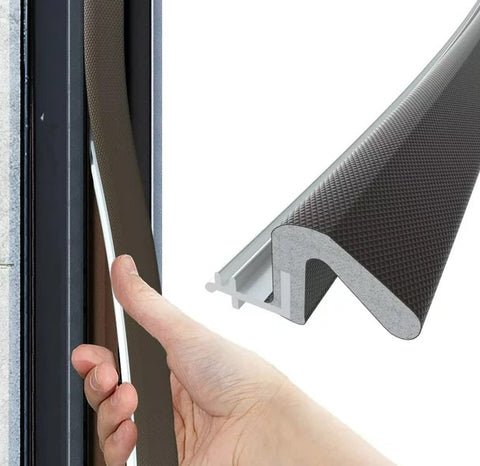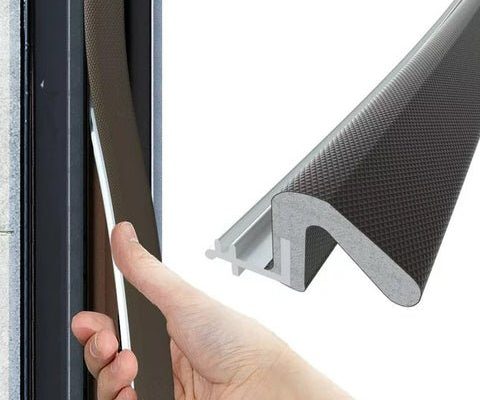
Here’s the thing: not all weatherstripping is created equal. Q-Lon, for example, has its own quirks and perks. If you’ve ever wondered why your weatherstripping isn’t working like it used to, or if you’re nervous about accidentally damaging it while cleaning, you’re in the right place. Let’s break down the best ways to clean and maintain these materials so they work like new, season after season.
What Makes Q-Lon And Other Weatherstrip Materials Unique?
Honestly, if you’re picturing weatherstripping as just a thin piece of rubber, you’re not alone. But the reality is a bit more complex. Different materials serve different purposes, and Q-Lon is a type that’s stood out for decades. Rather than just plain foam or simple rubber, Q-Lon combines a foam core with a durable outer “skin”—usually polyethylene or polypropylene. Think of it as a high-tech sandwich: the foam gives flexibility and insulation, while the outer layer repels water, dust, and the occasional overenthusiastic cleaning rag.
Why does this matter? For starters, *Q-Lon* weatherstrip materials are tougher and usually last longer than basic rubber strips. You might notice they don’t flatten out as quickly, and they’re less likely to crack in the summer heat or winter cold. But that outer skin can be finicky: if you use harsh cleaners or scrub too hard, you’ll end up peeling or weakening it. Other materials, like plain rubber, vinyl, or silicone, have different strengths and cleaning needs. Knowing what you’re working with is everything when it comes to maintenance.
Here’s a quick story: years ago, my neighbor tried to “help” by scrubbing his Q-Lon weatherstripping with a wire brush and bleach water. The strip turned gummy and peeled in days. Lesson learned—the right material needs the right touch.
Why Regular Cleaning Matters For Weatherstripping
You might be wondering, “Do I really need to clean my weatherstrip?” Short answer: absolutely. Just like you wouldn’t let dirt pile up on your car windshield, letting dust, grime, and mildew gather on weatherstripping cuts down its lifespan fast. All those small particles can act like sandpaper, grinding away at the surface every time you open a door or window.
Over time, gunk and debris can cause a few annoying issues:
- Dragging or sticking doors: When dirt builds up, the door doesn’t glide smoothly over the seal.
- Losing the seal: Dust and oils can stop the foam from compressing properly, letting in drafts.
- Mold and mildew: Water + organic dirt = musty smells and black spots no one wants to see.
Here’s the thing: it’s way easier to spend five minutes wiping down your Q-Lon seal than to replace the whole thing. Plus, keeping it clean helps it stay flexible, so it can keep doing its job—blocking air leaks and saving you money on energy bills.
How To Safely Clean Q-Lon Weatherstripping
Let me explain how to clean Q-Lon weatherstrip the right way. You don’t need harsh chemicals or fancy tools—just a little patience and the right technique.
Step-by-step process:
- Brush off loose dirt: Use a soft-bristle brush or a dry cloth. Be gentle—think of dusting a nice pair of boots.
- Mix a mild cleaning solution: Combine a few drops of dish soap in a bowl of warm water. Skip bleach or ammonia—they’ll ruin the outer skin.
- Wipe the weatherstrip: Dip a clean cloth in your soapy water, wring it out, and gently wipe the strip. Avoid saturating the foam—it’s water-resistant, not waterproof.
- Rinse with a damp cloth: Use a separate cloth dampened with plain water to remove soap residue.
- Dry thoroughly: Blot any remaining moisture with a towel, and let the area air-dry before closing doors or windows.
A few extra tips: never use abrasive pads, as they’ll scratch or peel the Q-Lon coating. If you spot sticky residue (like from tape or adhesive), try a dab of isopropyl alcohol on a cotton swab—just test in a hidden area first.
Maintaining Flexibility and Lifespan
Here’s something many folks forget: cleaning is only half the battle. Keeping weatherstripping flexible is what makes it seal correctly, especially with foam-core types like Q-Lon. Over time, even the toughest strip gets stiff or shrinks, especially if exposed to harsh sun or wild temperature swings.
To help your Q-Lon weatherstrip last:
- Check for flattening or cracking: If the foam isn’t springy or you see cracks, it’s time to replace it.
- Apply a silicone-based lubricant: Once clean and dry, a thin coat of silicone spray (not oil or grease) can keep the surface flexible. Spray onto a cloth, then wipe—don’t spray directly.
- Inspect seasonally: At least twice a year—spring and fall—give your weatherstrip a quick once-over. Look for brittle spots or places where the strip is separating from the door or window.
If you catch small problems early, you’ll avoid expensive headaches later. Think of it like checking tire pressure before a road trip—it’s a tiny effort that pays off big.
Regular cleaning and a dab of silicone spray can easily double the life of Q-Lon and similar weatherstrip materials.
Comparing Other Materials: Rubber, Vinyl, and Silicone Strips
It’s not all Q-Lon out there. If your doors and windows use other types—like basic rubber, vinyl, or silicone—the rules change a bit. Each material acts differently when it comes to cleaning and maintenance.
- Rubber weatherstripping: Usually plain black or gray, it wears out faster and is prone to cracking in sun or cold. Clean gently, and avoid petroleum-based products. Once it gets brittle, replace it—there’s no reviving it.
- Vinyl strips: These are smoother, and a bit tougher than rubber, but can become hard and shrink over time. Clean with mild soap and water, and keep out of direct sunlight if you can.
- Silicone strips: Flexible, long-lasting, and more resistant to harsh environments. They rarely need more than a wipe-down, but applying a touch of silicone spray helps them stay slick and soft.
Honestly, Q-Lon tends to outlast most of these options. But if you’re ever troubleshooting a draft and see a weird color or feel a different texture, check the material before you start scrubbing or spraying.
When To Replace Instead of Clean
Let’s be honest—sometimes, cleaning just isn’t enough. If your Q-Lon or other weatherstrip material is torn, peeling, or constantly letting in air or water, don’t waste time trying to patch it. Replacing is easier (and often cheaper) than you might think, and it’s one of the fastest ways to reboot your door or window seal.
Here’s how to spot the signs that you need to swap it out:
- Visible flats or splits: If the foam doesn’t bounce back, or the outer skin is splitting, time for a new one.
- Persistent drafts: If you’ve cleaned and lubed and air still sneaks in, the strip’s not doing its job.
- Mold that won’t go away: Deep-seated mildew or black gunk that returns after cleaning is a sign that the material is breaking down inside.
Swapping in new weatherstripping isn’t complicated—most Q-Lon comes with self-adhesive backing or simple staples. Just remove the old one, clean the surface, and press the new strip in place. Don’t forget to align it properly so it compresses evenly when you close the door or window.
Tips To Prevent Common Weatherstrip Problems
You might be surprised at how a few habits can make a big difference. Aside from cleaning, proper handling and installation go a long way.
- Don’t slam doors: Repeated slamming can crush or misalign Q-Lon strips. Teach kids (and yourself!) to close gently.
- Keep hardware in check: Worn out hinges or misaligned doors can pinch or peel the strip. If your door sags, fix it before swapping weatherstrip.
- Avoid paint spills or adhesives: Paint can gunk up the surface and prevent the strip from sealing. If you’re painting near it, use painter’s tape for protection.
- Control humidity: In really damp areas, a dehumidifier can cut down on mold or mildew forming on weatherstripping—especially near basement doors or windows.
A little care up front means fewer repairs down the line—and fewer trips out to get replacement Q-Lon weatherstripping.
At the end of the day, maintaining Q-Lon and other weatherstrip materials is about keeping your space comfortable and your energy bills down. It doesn’t take fancy supplies or hours of scrubbing—just gentle cleaning, a little bit of regular attention, and knowing when it’s time to swap out the old for the new. Whether you’re troubleshooting a mysterious draft or just want to make what you’ve got last, keeping your weatherstrip clean and flexible is a smart move.
Strong seals mean less noise, fewer leaks, and a home that feels just right no matter what’s happening outside. Treat your Q-Lon or other weatherstrip materials kindly, and they’ll keep doing their quiet, vital job year after year.
